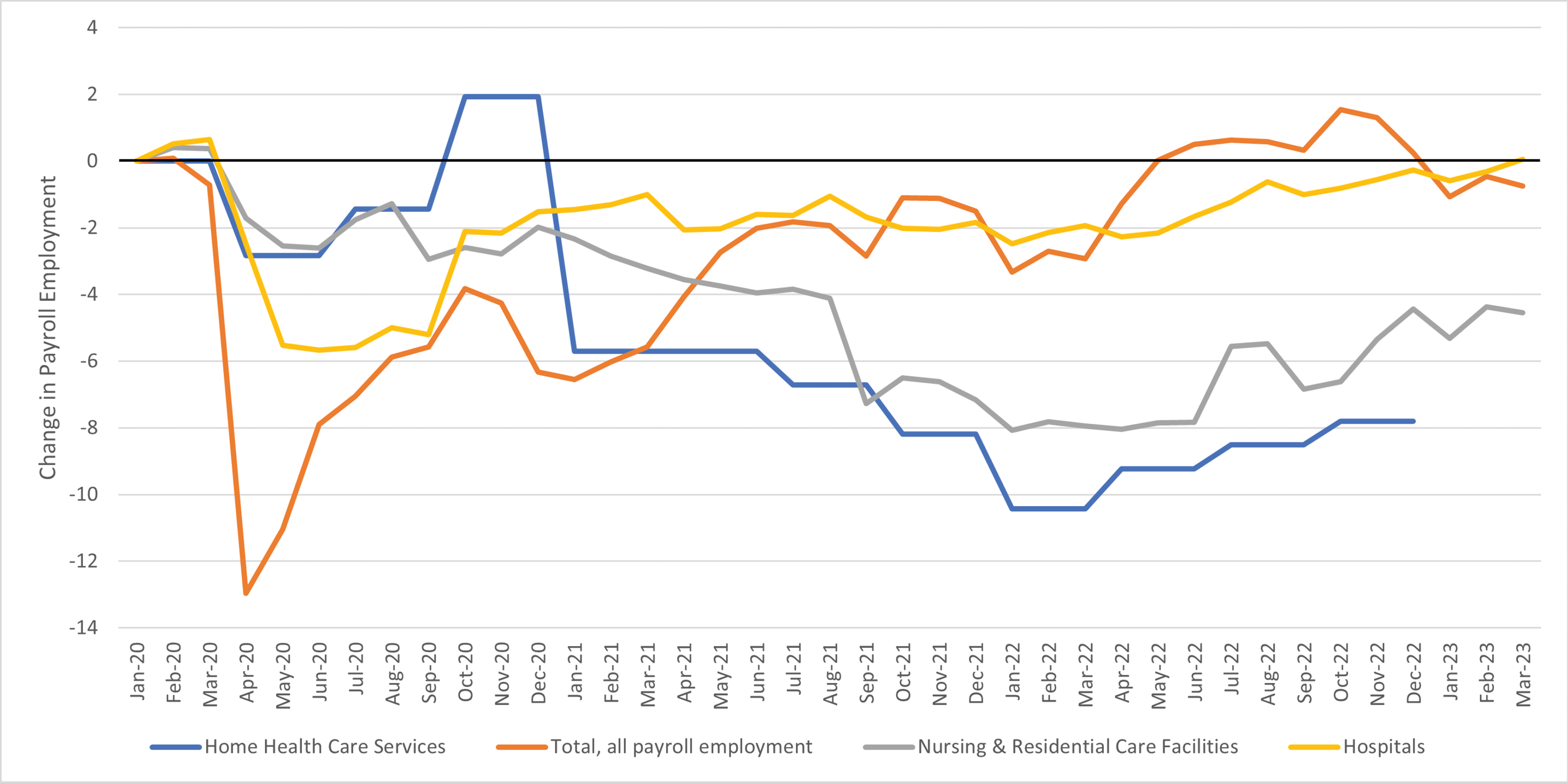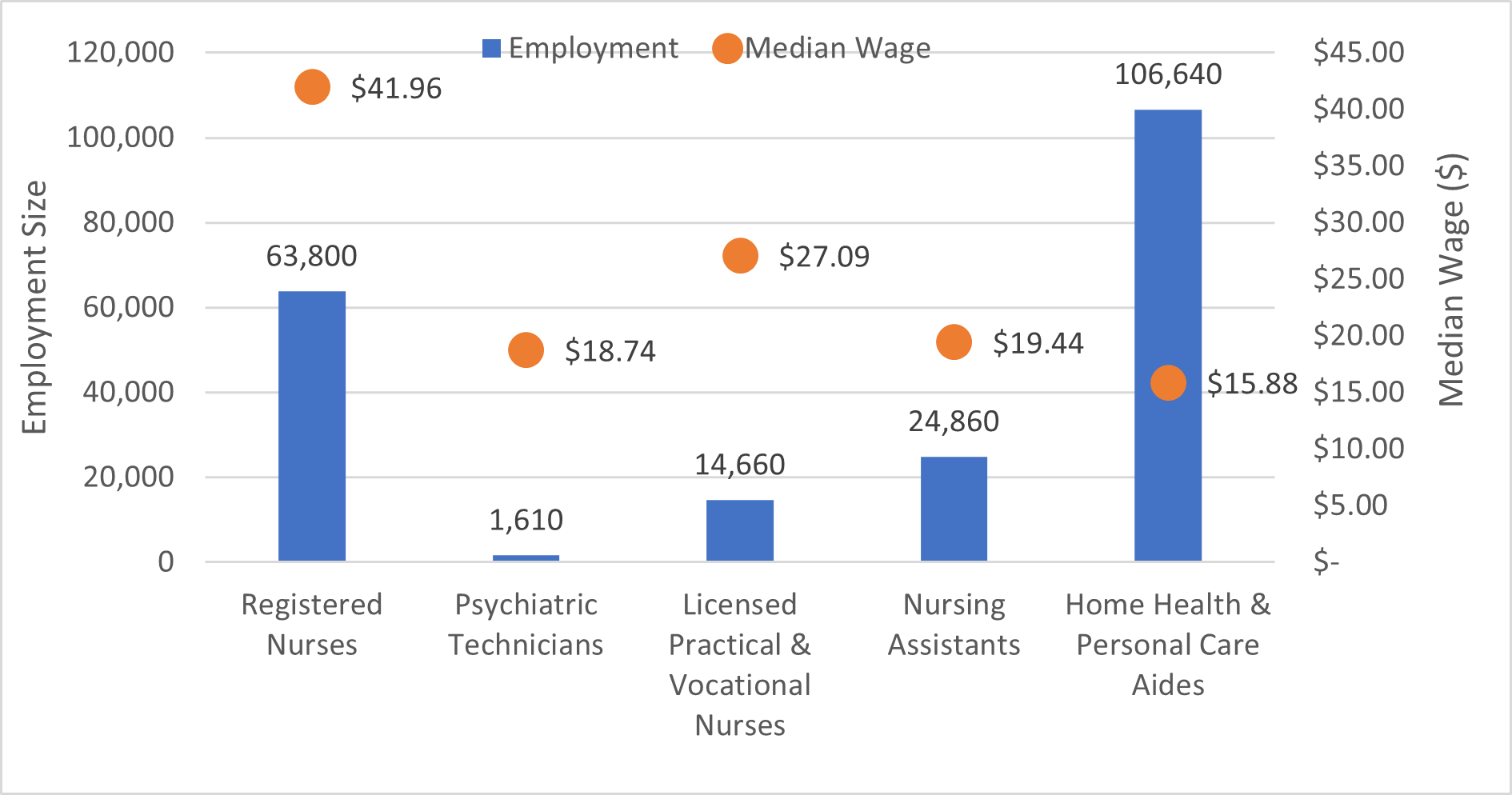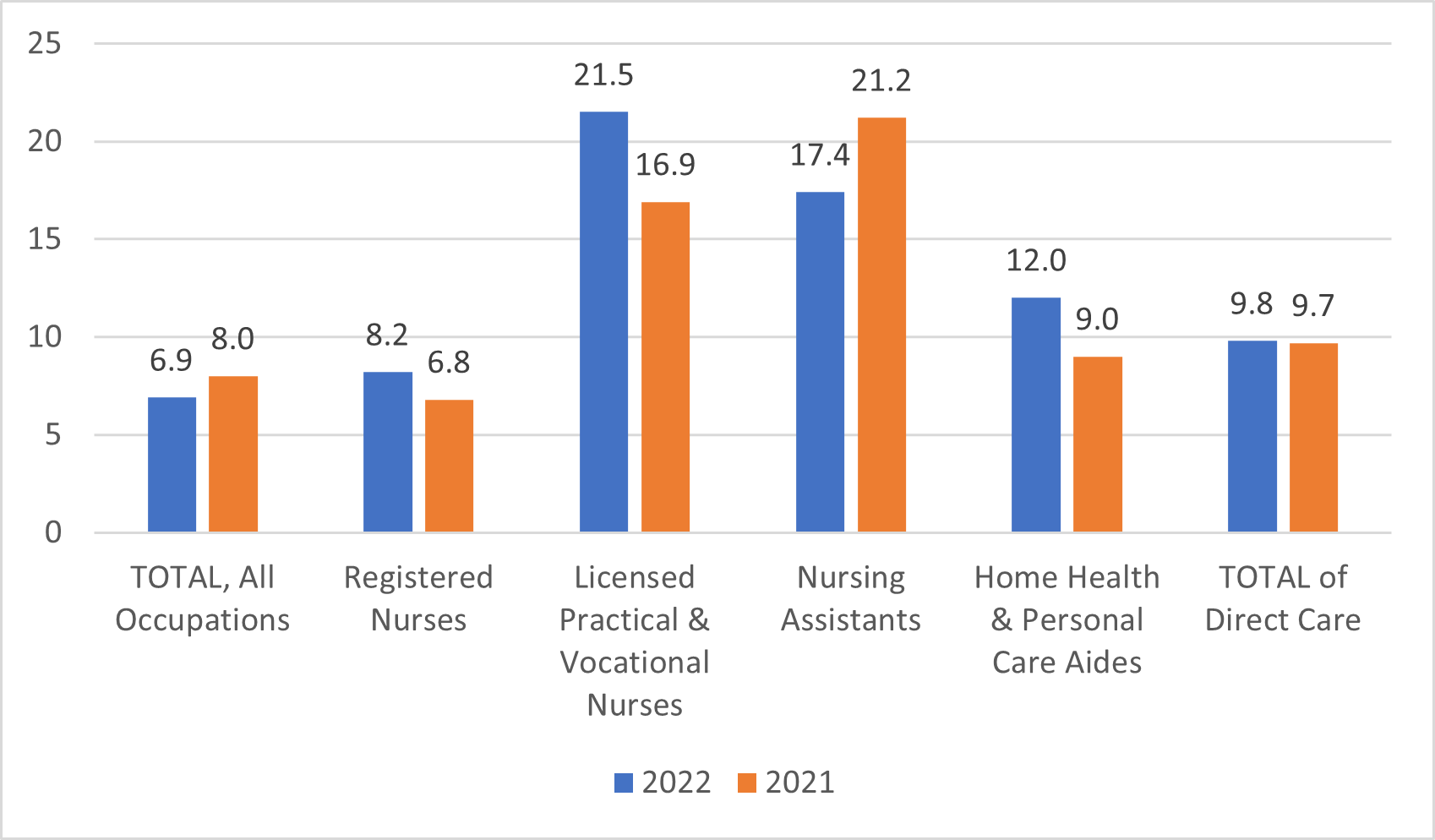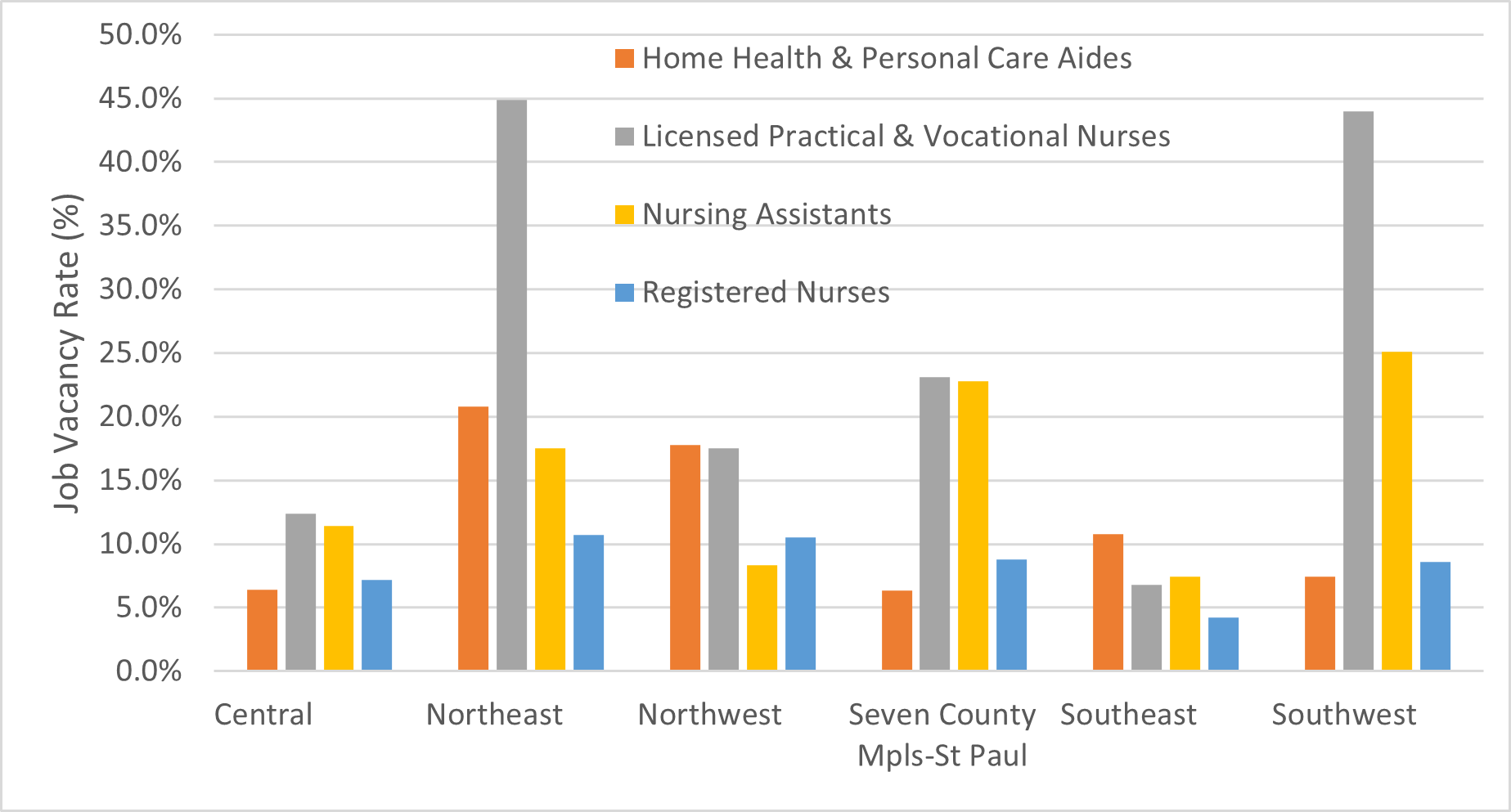
by Oriane Casale
June 2023
The direct care workforce, including Registered Nurses, Licensed Practical Nurses, Nursing Assistants, Home Health & Personal Care Aides and Psychiatric Technicians, directly care for the sick, elderly and people with disabilities in hospital, nursing and residential care facilities and in clients' homes. These jobs range in skill level and pay but can all be physically and emotionally exhausting and require in-person work. Like in most states, Minnesota's direct care workforce was heavily impacted by the Pandemic Recession and is taking longer than other industries to recover. This article describes this workforce in terms of employment, wages and job openings.
The COVID-19 pandemic hit the direct care – sometimes called the Caring Career – workforce hard. While nursing retirements have been in the news, less visible has been the movement of other direct care workers out of Nursing & Residential Care Facilities and Home Health Care Services employment. While Hospital industry employment (yellow line) is back to its level just prior to the COVID-19 pandemic (black line), mirroring overall employment trends in Minnesota, employment in the Nursing & Residential Care (gray line) and Home Health Care Services (blue line) industries are still well below their level prior to January 2020. Nursing & Residential Care is almost 5,000 jobs below its level in January 2020, or 4.5% lower. Home Health Care Services is 2,000 workers lower, or 7.8% (see Figure 1).
Much of decline in employment in Nursing & Residential Care Facilities and Home Health Care Services was the direct result of a very tight labor market where workers could find better paying, and less physically and emotionally demanding work. Pay increases of more than 10% over the year started to kick in at the end of 2021 in Nursing & Residential Care Facilities helping stabilize the workforce in the first half of 2022 and then grow employment since then. Home Health Care Services employment has also benefited from pay increases, largely a result of a succession of hard-fought labor negotiations by workers of the largest union – SEIU – in this sector.

Source: Total, all payroll employment, Nursing & Residential Care and Hospital employment is from the Current Employment Survey, monthly data from January 2020 through March 2023. Home Health Care Services employment is from the Quarterly Census of Employment and Wages, quarterly data from January 2020 through December 2022.
Many people work in direct care occupations, which make up 7.5% of Minnesota's total workforce. In fact, Home Health & Personal Care Aides is the single largest occupation in Minnesota with close to 106,640 workers, while Registered Nurse is the fourth largest with 63,800 workers. Nursing Assistants comprise 24,860 workers, with Licensed Practical & Vocational Nurses at about 14,660 and Psychiatric Techs at 1,610 (see Figure 2).

Source: Occupational Employment Statistics, First quarter 2023 data
Median wages for these occupations range from $41.96 per hour for Registered Nurses to $15.88 per hour for Home Health & Personal Care Aides, as of first quarter 2023. Comparing these wages to occupations with similar educational requirements, Registered Nurses are at the top end of occupations that require an associate's degree. Air Traffic Controllers, Nuclear Medicine Technologists and Diagnostic Medical Sonographers earn a higher median wage but the vast majority of occupations at this educational level earn somewhat less including MRI Technologists, Respiratory Therapists, Radiation Therapists and Dental Hygienists.
Nursing Assistants require short-term training toward a certification. Wages for this occupation just meet the cost of living for the most typical family type in Minnesota, which is a two-partner family with one child, where one partner is working full time and one partner is working part time. This family type requires a combined salary of $60,720 or an average wage of $19.46 per hour for each partner to meet the basic cost of living in Minnesota. The cost of living for a single adult in Minnesota is $34,992 per year or $16.82 working 40 hours per week based on the 2023 Cost of Living data.
Among occupations with similar educational requirements, Nursing Assistant median wages at $19.44 per hour fall toward the bottom of the list, above Hairdressers and Manicurists but below Medical Assistants, Massage Therapists, Medial Transcriptionists and Dental Assistants as well as a number of manufacturing production occupations.
Home Health & Personal Care Aides, have many other options to earn similar or higher wages to the $15.88 they make on average per hour in Minnesota. Moreover, job seekers may foresee difficulty even affording to take the job, which generally requires a well-functioning vehicle and the gas needed to get to clients' homes. In addition, unless workers can support multiple clients, this occupation tends to offer part-time hours. For some people, part-time hours and scheduling flexibility are a key draw to working in this field.
In addition to people working in home health in the very large Home Health & Personal Care Aides occupation, there are many people in this occupation who work in group homes or in other settings providing care and support to people with disabilities and elders. These positions may be in locations accessible by public transportation and can be a good fit for people without their own vehicle.
Of the over 300 occupations that require no education beyond a high school diploma, Home Health & Personal Care Aides are at the lower end of the list in terms of median hourly wage. Fast Food & Counter Workers, Retail Salespersons and Childcare Workers earn similar or slightly less, but most occupations in this category earn more including Maids & Housekeeping Cleaners, Light Truck Drivers, Stockers & Order Fillers, and Security Guards.
Direct care occupations are high demand, totaling 12% of job vacancies statewide. They all have high job vacancy rates, with a combined rate of 10% compared to 6.9% on average for all occupations. Compared to 2021, vacancy rates were slightly higher in 2022 in these direct care occupations combined. However, it is noteworthy that Nursing Assistants have a lower job vacancy rate in 2022 than in 2021 (see Figure 3). This bears watching in subsequent years.

Source: Minnesota Job Vacancy Survey, 2021 and 2022
Vacancy rates vary between regions in direct care occupations. Licensed Practical Nurses and Nursing Assistants have very high rates in Northeast, Southwest and the Twin Cities. Home Health & Personal Care Aides have highest rates in Northeast and Northwest (see Figure 4). This may be a result of the difficulty of getting to clients in more rural areas.

Source: Minnesota Job Vacancy Survey, 2022
Foreign-born workers make up 18% of the direct care workforce in Minnesota, even though they only make up 12% of the workforce overall, in this state. They make up an even higher share of Home Health and Personal Care Aides at about 27%. These statistics points to the importance of helping prepare immigrants, refugees and evacuees for this work, which can in turn prepare people for further career growth in health care, social services, education or other fields.
Minnesota's high school graduates are an important source of new workers across the economy. Working as a Home Health & Personal Care Aide right after high school can provide important work experience and potentially lead to a well-paid career in the health care sector with additional education. However, too many high school grads who do not go directly on to college are underemployed in their year after graduation. Of the almost 15,700 high school students who graduated in 2021 and were not enrolled in college in fall of 2021, 71% were employed 20 or fewer hours per week in the year following graduation. This is a potential pipeline of direct care workers who could both benefit the occupation with new energy as well as benefit themselves with direct care experience that could lead to a fulfilling career in a high demand sector.
Minnesota's labor force is not growing quickly enough to meet demand – in fact without an increase in international or domestic migration, it's not expected to grow much at all over the next two decades. This is due to Baby Boomers retiring and not enough young workers to take their place. Direct care positions will continue to witness high demand – in part due to Baby Boomers needing more services as they age – but also because people will keep retiring from or otherwise moving on from direct care positions. An increase in wages for direct care positions could help attract more people to these positions, as could more efforts to introduce young people in high school and college to work in this field. However, for the foreseeable future, demand for direct care workers will likely continue to outstrip supply.